Growing salvia sparkling

Salvia sparkling is very popular with gardeners and owners of private country houses. This plant allows you to create a spectacular landscape composition, give the garden plot an unusual look, and decorate the cottage. We will tell you about all the features of this flower in our article.
Description
Salvia brilliant, also known as brilliant sage, is a cultivated perennial of the sage genus. Plants were well known even in the distant ancient era, mentions of them are found in the writings of the famous ancient Greek healer Hippocrates. However, there are varieties that have been discovered relatively recently. So, in 1962, the so-called sage of the diviners was found in the Mexican mountains. And in recent years, breeders have bred many varieties of salvia, intended for decorative use.
In its natural environment, this culture grows in the tropics of Brazil. This is a very thermophilic plant, therefore in the climatic zone of Russia it is grown mainly as an annual.
Consider what the glittering salvia is. This is a low and medium-sized shrub, completely covered with opposite leaves. The edges of the leaf plates are solid, the width corresponds to 2.5-3 cm. They can have a different appearance - from shiny to velvety, veins are clearly visible on the surface. The outer side has a rich green tint, the back is lighter.

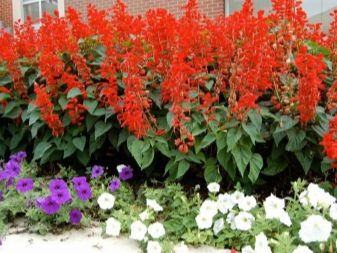
The bush has a reverse pyramidal shape. This is a fairly compact plant, it practically does not grow in breadth, so sage should be planted with a small interval of 15-20 cm. At the same time, the root system is quite powerful, branched. It actively occupies the planting space and absorbs moisture from the ground, as well as useful micro and macro elements.
The flowers are large, they are distinguished by a double perianth and irregular outlines. They are collected in cluster inflorescences 15-25 cm in size, each consisting of 30-90 small flowers. Shades are predominantly rich red, although depending on the varietal characteristics, sparkling sage can be pink, coral, snow-white and even purple.


Flowering lasts from the second decade of June, until October, as a rule, ends with the arrival of the first frost. Thus, the brilliant salvia adorns the landscape with its appearance throughout the growing season.
The fruit is four nuts with seeds soldered to each other, they retain their germination capacity for 3-5 years.
Some varieties of salvia can be successfully grown at home - in this case, the seedlings are planted for seedlings. When working with hybrids, collecting seeds does not make any sense, since such plants do not produce flowers.
For these varieties of salvia, it is advisable to buy seeds in specialized stores.
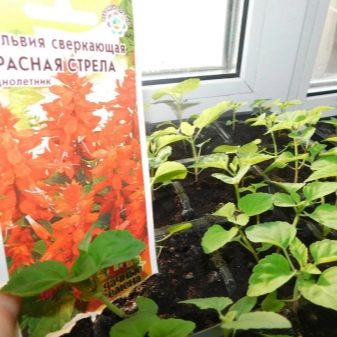

Varieties
Today, about 10 varieties of glittering sage are used in horticulture. Let's dwell on the most popular ones.
Carabiner
This type of salvia is a low-growing shrub no more than 25-30 cm high. The plant is herbaceous, the stem is tetrahedral. Inflorescences are tubular, deep red. This sort of sage has found its use in decorative plantings, it is used to decorate borders, as well as as part of ridges and mixborders.

Scarlet
One of the tallest bushes, it can grow up to 60 cm. It is distinguished by its long flowering time and resistance to dry weather. Sage Scarlet easily withstands a short-term cold snap, as well as other external adverse weather conditions. The plant is commonly used to decorate garden paths, it is grown in flower beds and ridges.
This culture looks very beautiful in flower pots and pots.

Dwarf mix
Densely leafy low-growing plant up to 20 cm high. The color of inflorescences is very diverse - red, dark orange, as well as lilac, purple or white. It blooms in mid-July and pleases with its exuberant flowering before the arrival of negative temperatures. Salvia of this variety is grown in borders and flower beds.
This sage is quite compact, so it is advised to plant it in 20-25 cm increments.
Keep in mind that this is a thermophilic culture, so it is recommended to transfer it to open ground no earlier than mid-June. This type of plant prefers lightweight, drained and nutritious substrates. If the soil is clay, then it is necessary to add river sand to it at the rate of 2-3 kg / m2.
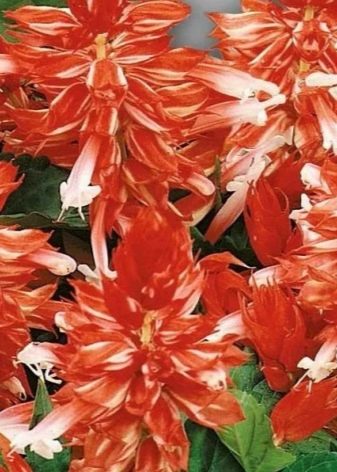

Dwarf ed
Salvia Dwarf red is a compact bush up to 30 cm high. The plant is abundantly covered with leaves. It is distinguished by inflorescences in the form of a panicle of a juicy red hue. The number of buds is large, so this sage looks very decorative.

Bonfire
Another tall variety of salvia, reaching a length of 60 cm. The bush is densely leafy, giving a large number of spectacular inflorescences of a rich red hue. It got its name due to the fact that in a lush planting it looks like a fire.


Charm cherry
A compact bush 25-30 cm long, has a delicate cherry hue. The inflorescences are rather large, their length is 15-25 cm. This variety is distinguished by exceptional decorativeness, its flowering lasts throughout the summer and captures part of the autumn months. Salvia Sharm cherry has become widespread in the design of central flower beds and flower beds, it looks especially advantageous against the background of well-groomed lawns.
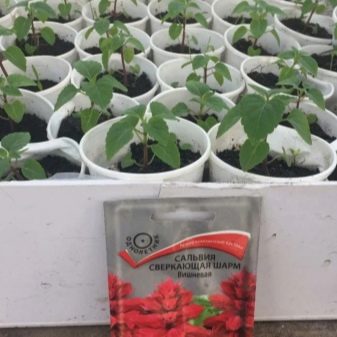

Fire of Prometheus
One of the shortest varieties, the height of this bush is 15-20 cm, rarely grows up to 30 cm. Flowers of bright scarlet color look beautiful and neat, with their appearance they can revive even the most ordinary-looking corners in the garden. At the same time, flowering is quite long - it lasts from the beginning of July, until the onset of the first frosts.

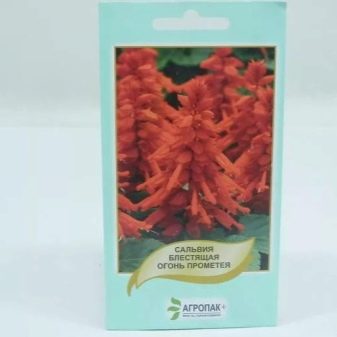
Splendis pink
This type of glittering sage is popular for its light lilac and pinkish flowers. Flowering lasts from early July to October. Small bushes, up to 25 cm tall, densely leafy. This variety prefers good moisture and sunlight.

Vesuvius
Another type of sparkling sage with large inflorescences in the form of scarlet panicles. The leaves are large, up to 10-12 cm long and up to 8 cm wide.The bushes are medium-sized - from 40 to 55 cm.

Landing
In order for the plant to develop successfully, it is important to plant it correctly.
Seat selection
Salvia is planted in open ground rather late - not earlier than the second decade of June. This sage spends almost half of the entire growing season in a pot. When choosing a site, preference should be given to well-lit, not shaded corners. Sage cultivation is not suitable for places with a high level of groundwater occurrence, as well as lowlands, where moisture is often stagnant. Sage beds are usually not planned in advance; most often, salvia is planted in place of daffodils, tulips and other dug-out bulbous or summer plants, which by the beginning of July have time to lose all their charm, for example, pansies.


Preparation of soil and planting material
Sage is not particularly demanding on the structure and composition of the soil. However, it is better to loosen heavy soils with sand. Wherein it is undesirable to fertilize the area where salvia is planned to be planted with humus or compost - in this case, the root system will actively develop, but there will be few flowers.
The use of manure is allowed only on depleted land, in this case it is applied once at the rate of 2 kg per 1 m2 of planting area.
If salvia is planted in a greenhouse or greenhouse with seeds, then it is necessary to prepare the planting material. It includes several stages.
- Germination test. Warm water is poured into a cup, seeds are poured there for one to two hours. High-quality seedlings will sink to the bottom, and unviable dummies will remain floating on top - they will not give seedlings.
- Disinfection. The grains are wrapped in a piece of gauze and kept for 15-20 minutes in a pale solution of potassium permanganate, followed by rinsing with running water.
- Drying. Until the moment of sowing, the calibrated, sorted and disinfected seeds are dried on paper.

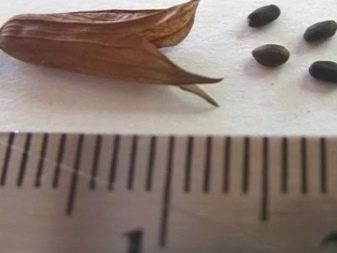
Disembarkation
Planting salvia is not particularly difficult.
- First, it is necessary to form several shallow holes at a distance of 20-30 cm from each other, depending on the features of the landscape design.
- The bottom of each hole is laid out with expanded clay or any other drainage.
- After that, the seedling is rooted, then covered with fertile soil mixture.
- At the end of planting, the land is actively watered, covered with a layer of mulch.
Care
As a perennial, glittering sage can survive only in areas with mild winters, when the temperature does not drop below -10 degrees. In temperate latitudes, the lack of heat is usually compensated by a location in sunny places. In the south, light shading is allowed.
To achieve abundant flowering, the soil must be nutritious, acidity in the range of pH 6.1-7.8. The culture grows best on sandy loam soils. Salvia can grow on depleted land, but rich flowering can only be achieved on fertile substrates. Therefore, during the season, it is necessary to fertilize the plant two or three times; for this, complex preparations intended for flowering crops are suitable.
Despite its drought tolerance, sparkling sage requires regular watering to bloom intensively. At the same time, irrigation should be moderate, since excess moisture leads to the wilting of this crop. In addition, the plant needs to be regularly weeded from weeds, and the faded inflorescences should be cut off.



Diseases and pests
Under unfavorable weather conditions, glittering sage may encounter diseases such as late blight, fusarium and black leg. In the summer months, insect pests can parasitize on fragrant bushes, most often the plant is affected by aphids and thrips. For prevention, you must strictly observe a comfortable irrigation regime, as well as immediately after moving into open ground, treat salvia with fungicidal agents - Skor, Ordan, Fitosporin, as well as Maxim or Fundazol.
If the insects have already settled in the flower bed, to combat them, they are treated with the preparations "Aktara", "Fitoverm", "Decis" or "Confidor".



Reproduction methods
Salvia brilliant propagates by cuttings and seeds. The seed method is quite laborious, however, by growing seedlings, the time of the beginning of flowering can be significantly brought closer. Breeding with cuttings is much easier. It is noteworthy that in this case, young plants will fully retain all the varietal characteristics of the parent bush.
Cuttings
It is advisable to propagate brilliant sage cuttings at the end of August or at the very beginning of September, when the main flowering wave has already passed, and the bush is sufficiently strong. The sequence of actions includes a number of steps.
To begin with, you should select several healthy green shoots, and cut 10-12 cm cuttings from them.
The workpieces are placed in a container with water, protected from ultraviolet rays.You can add a little "Kornevin" or another growth stimulant to the water.
After a couple of days, the planting material is carefully examined, and if withered leaves are found, they are separated.
In comfortable conditions, the cuttings give roots after two weeks, immediately after that you can plant in a separate pot.


Seeds
Seedlings are usually obtained from salvia seeds. They are planted at the end of February, but not later than the beginning of March, otherwise the flowering will be late and short. The soil can be taken both purchased and made up independently. The seeds are first placed in one common container. After the appearance of 3-4 full-fledged leaves, young plants dive in separate pots. At first, the seedlings need to maintain greenhouse conditions - for this they are covered with a film and abundantly moistened. As soon as the plants get stronger, the shelter is removed, and cultivation is continued at room temperature.

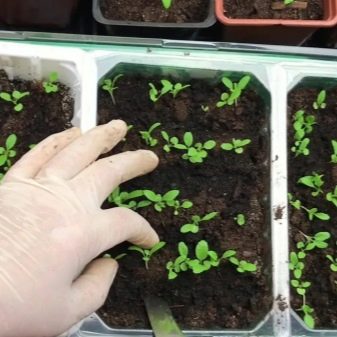






























































The comment was sent successfully.